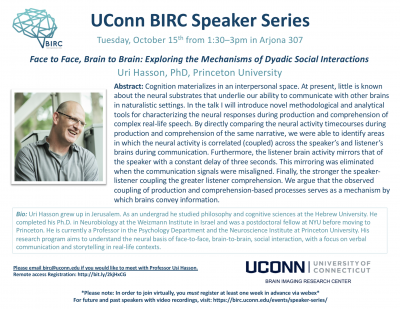Uri Hasson, PhD
Princeton University
Tuesday, October 15th from 1:30-3:00 pm in Arjona 307
Abstract: Cognition materializes in an interpersonal space. At present, little is known about the neural substrates that underlie our ability to communicate with other brains in naturalistic settings. In the talk I will introduce novel methodological and analytical tools for characterizing the neural responses during production and comprehension of complex real-life speech. By directly comparing the neural activity timecourses during production and comprehension of the same narrative, we were able to identify areas in which the neural activity is correlated (coupled) across the speaker’s and listener’s brains during communication. Furthermore, the listener brain activity mirrors that of the speaker with a constant delay of three seconds. This mirroring was eliminated when the communication signals were misaligned. Finally, the stronger the speaker- listener coupling the greater listener comprehension. We argue that the observed coupling of production and comprehension-based processes serves as a mechanism by which brains convey information.
Bio: Uri Hasson grew up in Jerusalem. As an undergrad he studied philosophy and cognitive sciences at the Hebrew University. He completed his Ph.D. in Neurobiology at the Weizmann Institute in Israel and was a postdoctoral fellow at NYU before moving to Princeton. He is currently a Professor in the Psychology Department and the Neuroscience Institute at Princeton University. His research program aims to understand the neural basis of face-to-face, brain-to-brain, social interaction, with a focus on verbal communication and storytelling in real-life contexts.
**To view this talk remotely via Webex, please register here by October 8th**
Please email birc@uconn.edu if you are interested in meeting with a speaker. Click here to see the full BIRC Speaker Series schedule and access recordings of past talks.
